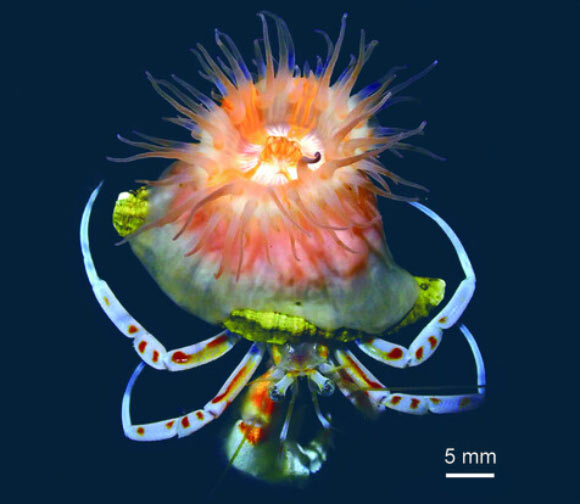The new species of hermit crab-associated sea anemone, Paracalliactis tsukisome, secretes and constructs a unique shell-like structure known as a carcinoecium, which expands the host hermit crab’s living space, according to a team of marine biologists from Japan and Australia.

Paracalliactis tsukisome. Image credit: Yoshikawa et al., doi: 10.1098/rsos.250789.
Paracalliactis tsukisome is the ninth valid species of sea anemone in its genus, Paracalliactis.
This genus previously comprised eight species, one questionable species, Paracalliactis involvens, and one undescribed species, all found exclusively on shells inhabited by hermit crabs.
Most Paracalliactis species inhabit the deep-sea floor (approx. 200-4,700 m depth), while two species, Paracalliactis rosea and Paracalliactis sinica, have been recorded in shallow to deep depths of 50-3,000 m and at shallow depths of 39-40 m, respectively.
“Our discovery shows how even simple animals like sea anemones can evolve surprisingly sophisticated behaviors,” said lead author Dr. Akihiro Yoshikawa, a researcher at Kumamoto University.
“Their ability to build a shell-like structure is a fascinating clue to understanding how animals perceive space and direction.”
Paracalliactis tsukisome was found living on the shells inhabited by the hermit crab Oncopagurus monstrosus at depths of 200-500 m off the Pacific coasts of Mie and Shizuoka prefectures, Japan.
Unlike typical sea anemones, which lack hard skeletons, this species secretes carcinoecium, which expands and reinforces the crab’s shell.
The team’s stable isotope analyses revealed that the anemone feeds partly on organic particles and the crab’s feces — an unusual but efficient form of recycling on the deep-sea floor.
Meanwhile, 3D imaging using micro-CT scanning showed that the anemone attaches to the shell in a consistent, one-directional pattern that may be linked to both feeding and shell-building behavior.
The hermit crab, in turn, benefits from this partnership by achieving a larger body size than its relatives, suggesting a true mutualistic relationship between the two species.
“Our study provides the first quantitative evidence of mutualism in carcinoecium-forming associations, highlighting a remarkable example of deep-sea symbiosis and hypothesizing how reciprocal benefits are refined over time, fostering the evolution of carcinoecium-forming abilities and species-specific mutualistic relationships,” the authors concluded.
Their paper was published on October 22 in the journal Royal Society Open Science.
_____
Akihiro Yoshikawa et al. 2025. Mutualism on the deep-sea floor: a novel shell-forming sea anemone in symbiosis with a hermit crab. R. Soc. Open Sci 12 (10): 250789; doi: 10.1098/rsos.250789







